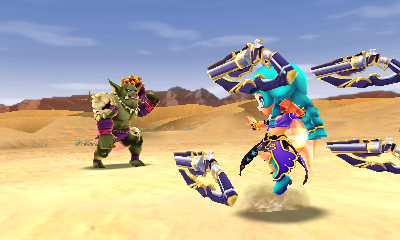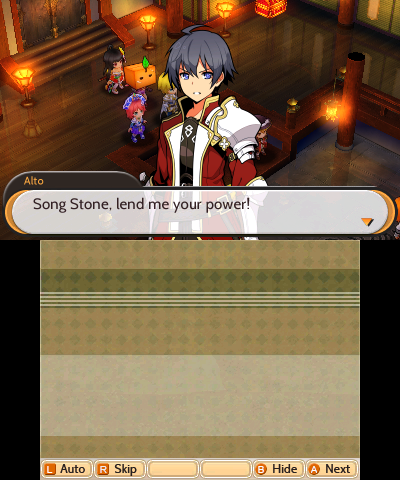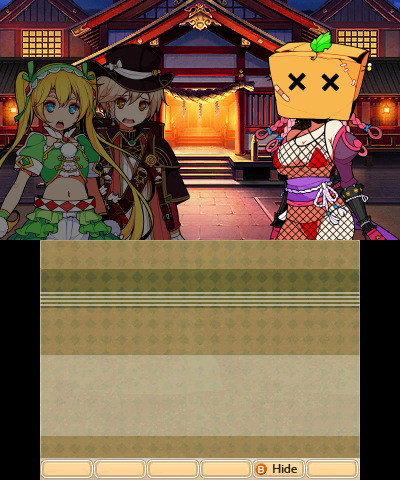Fun and engaging battle mechanics; story has some great moments of humor and drama; a fantastic soundtrack; New Game +; Nonoka, the box-headed ninja
A few story arcs fall flat; attempts to be cute and/or sexy often feel awkward and distracting; falls back on a few too many JRPG and anime tropes; Popo, the wind witch who needs to shut up and never talk again
Were I not reviewing Stella Glow I doubt I would have played more than a few hours of it. What started as a decent enough turn-based strategy JRPG turned into an incredibly frustrating slog through annoying characters, insipid storytelling, and highly awkward thematic elements. That being said, I’m glad I was reviewing the title, because past that a much better game was waiting to be played.
Stella Glow is the latest anime-flavored JRPG strategy game developed by Imageepoch and published by Atlus USA. To fans of distinctly Japanese games, these names mean quite a bit, with the former having established itself within the genre with the Luminous Arc series, and the latter being one of the most respected names in localizing some of Japan’s smaller, and oftentimes more niche offerings. All things considered, Stella Glow fits in quite well with both companies’ track record.
Your adventure takes place in the land of Regnant, a prosperous kingdom built on the legend of Elcrest, a hero with a magical connection with the world’s witches who managed to broker peace with an angry god that had unleashed an army of angels to obliterate mankind. One thousand years have passed since then and now the world is once again being threatened. A powerful witch is roaming the land, turning towns and their populations into crystal with the power of her magic-infused song. The key to stopping her is Alto, a teenage amnesiac who appears to possess the same powers as the legendary Elcrest. Alongside a group of Regnant’s bravest knights, Alto has to track down the world’s other witches and use his powers to unlock their full potential and stop the Witch of Destruction. Naturally, these other witches happen to be single and depending on your actions, might be willing to date our hero.

In case that wasn’t enough of a clue, Stella Glow combines a fairly typical fantasy-inspired strategy RPG with social/dating sim elements to create a game that is somewhat unique, albeit made up of many ideas clearly inspired by other games. The battle system felt quite reminiscent of Final Fantasy Tactics Advance, with the direction a character is facing at the end of their turn being especially important as attacking from the side grants bonus accuracy and attacks to the rear are guaranteed to land and deal bonus damage. The social elements of the game take place between battles when the story allows free time that you can spend with the members of your party. Your relationship with each character can be leveled up to unlock new skills as well as passive bonuses that can prove incredibly useful. Yes, this feels almost directly ripped from Atlus’ own Persona series, but it does add an extra layer of strategy as your free time is limited.
One aspect of Stella Glow‘s core gameplay that I found surprisingly effective is the fact that your part is limited by a relatively small selection of central characters. Rather than building an army of generic characters who can be one of any number of classes, you must choose among the game’s core cast of characters, each with well defined strengths, weaknesses, and tactical opportunities. Many of the characters do fit into fairly well-defined archetypes, such as healers, tanks, and ranged fighters, but there are some interesting twists within the group and each character feels unique and useful in particular circumstances. If there is one minor complaint I might have in this area it would be that the game is balanced in such a way that characters with high mobility stats ultimately prove the most useful. Terrain type plays a major role in many battles, so having characters with perks to ignore certain movement penalties or large enough ranges not to be as severely affected will likely end up with a lot more play time than the slower characters.
The most unique mechanic in the game’s battles revolves around the witches and Alto, the main character. In addition to the usual sets of spells and skills, each witch will learn songs that either result in potent area-of-effect attacks, give powerful buffs to surrounding allies, or cripple nearby foes with status ailments. Using these songs consumes a bar that builds up as your characters wage battle against your foes, but those who wait for the bar to fill up near max will get access to the game’s most powerful moves. When enough energy is available, you can move Alto near a witch to “conduct” her; this will immobilize the witch for several turns as she sings a song that grants massive bonuses to all allies and/or sever penalties to all the enemies. For example, Lisette the water witch will fully heal every character at the end of each turn while Popo the wind witch will lock enemies in place for a turn and grant every ally huge bonuses to speed and movement range. Conducting is an incredibly powerful tool that is well-implemented to avoid being too overpowered, thanks in large part to the fact that to use it you will have to resist using the less powerful, but still super useful song skills. However, conducting also reveals a weird issue that you may or may not have with the game.

Preposterously dressed anime girls with ample cleavage is nothing new in the genre, but Stella Glow goes a few extra steps to make itself strangely sexualized. Whenever you use the aforementioned Conducting skill, you are shown a brief in scene of Alto using a dagger-like artifact to, for lack of a better word, penetrate the power granting gem in each witch’s chest. The fact that many of the witches accompany this action with a euphoric moan further erodes any hint of subtlety. Furthermore, to progress your relationship with each witch, you will have to occasionally “tune” them by visiting a specific location that requires the witches to don a nightgown for some reason. Fans of dating games or harem anime about men being surrounded by beautiful women fighting for their affection will likely see this as par for the course, but as someone more interested in the gameplay mechanics and narrative, I found it somewhat strange and distracting. Overall it didn’t have any real impact on my enjoyment of the game, but I could definitely see how some might find it kind of tasteless.
The main reason I was able to look past Stella Glow‘s awkward attempts at being sexy is because in addition to enjoying the combat mechanics, I legitimately enjoyed most of the story and many of the characters. As I stated at the start of this review, one of the early story arcs was damn near insufferable and heavily featured the game’s most annoying character; Popo might be an extremely useful character in battle, but every word she uttered was like a dagger to my brain. Part of the problem is the game’s attempts at being cute, which are quite frequent near the beginning and drag the much more interesting plotlines to a screeching halt. Some people might find the frequent discussions about cake or Popo’s inability to do basic math charming, but I’d much rather get back to trying to save the world.
It might sound like I’m being overly negative, but for every character and story misstep there are multiple instances of things being done decently enough or even exceptionally well. Some of the attempts at humor are effective, such as Lisette’s ability to cook delicious food despite the fact it always turns out purple for some strange reason. And then there is Nonoka, a ninja who’s attire consists of a bikini that’s several sizes too small, a fish net body suit, and a box that she wears on her head throughout the vast majority of the game. Pretty much everything Nonoka does is hilarious, if not just for how the eye holes on her box change shape depending on her mood; and the fact that she was one of my favorite characters to bring into battle was just the icing on the cake. In addition to some effective comedy, there are also some very good dramatic moments throughout the story. I don’t want to spoil anything, but I will say that the segment when you go to recruit the earth witch is especially strong with some great backstory between a party member and one of the villains and a genuinely shocking twist that is actually kind of disturbing when you really think about it.

Between the annoying and brilliant parts is a lot of perfectly acceptable material. Many of the characters will feel familiar to anime and JRPG fans and the story’s big twist is only partially shocking; you’ll probably see it coming though the question of who is responsible is less obvious. The manner in which the story is presented is also somewhat limiting. The vast majority of proceedings are presented via static character portraits and text boxes, which results in some weird and unsuccessful attempts at physical humor. It does kind of help that quite a bit of the dialogue is voiced with some strong performances, but what is and isn’t voiced feels somewhat random so the transition from listening to reading can be somewhat jarring. Once again, these aren’t the sort of things that have a big, negative impact on the game, but it makes you realize how the game could have been just that much better if the developers had gone the extra mile beyond what seems to be the norm for JRPGs on 3DS.
Thankfully, the game’s visuals and soundtrack do exceed the status quo. Putting aside the big boobs and impractical garments, the character designs are generally quite strong, with lots of great details that really fit their individual characteristics. The visuals during the battles are also exceptional, with some great environments serving as your battlefields and detailed character models and attack animations giving the everything that extra layer of pizzazz. And then there is the soundtrack, which is really good, with only a few tracks feeling somewhat dull. Yasunori Mitsuda, best known for his work on Chrono Trigger and Chrono Cross, contributed to the music of Stella Glow and you can tell, because many of the songs are head and shoulders above and beyond what you hear in the vast majority of games today, regardless of genre. Also, I want to commend the game for the witches’ songs. While a witch’s conducting move is active, the game plays a song sung by the original Japanese voice actress and these compositions were surprisingly good, eschewing standard pop sounds for some surprisingly complex and even exotic sounding works; it definitely wasn’t what I was expecting.
Succinctly summarizing Stella Glow has proven surprisingly difficult. In many ways it feels like your average JRPG strategy game, and in some places it even stumbles over itself with attempts at being cute or sexy. However, there are also enough strong points that really shine through and make the game stand out from the crowd, even if its best features are reminiscent of ideas from more noteworthy titles. Regardless, the sum of Stella Glow‘s parts is a game that is easy to recommend to dedicated fans of the genre and is worth a consideration from those of you looking for a JRPG or strategy game at the moment. Yes, you might come across a few bumps, but the road eventually does even out and lead to what is ultimately a satisfying game.
Nintendojo was provided a copy of this game for review by a third party, though that does not affect our recommendation. For every review, Nintendojo uses a standard criteria.




 ShareThis
ShareThis





